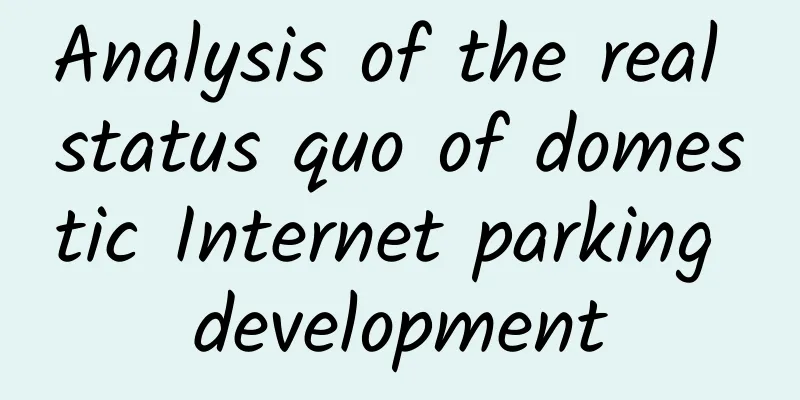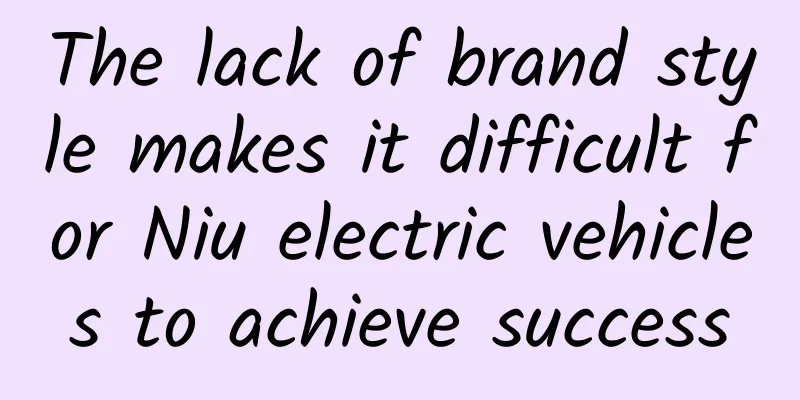Analysis of the real status quo of domestic Internet parking development

|
The current status of my country's traditional parking industry includes four major pain points: a large gap in total volume, a relatively scattered structure, scattered management, and a low level of intelligence. This directly leads to many problems such as difficulty in finding a parking space on the demand side, poor parking experience, high vacancy rate on the parking supply side, and high management costs. "Internet + Parking" connects scattered parking lots through the Internet, breaks down information silos, and optimizes the allocation of limited parking resources. Driven by the three major driving forces of the sharing economy, capital influx, and favorable policies, various parking apps have emerged in the "Internet + Parking" market. According to incomplete statistics, there are currently more than 100 parking apps nationwide. So, after the pie gradually appears, what is the real status of the development of domestic Internet parking? What potential development and investment value does it have? Four types of players There are four main types of players in Internet parking: 1) Startup companies; 2) Smart parking equipment vendors; 3) Municipal traffic management departments; 4) BAT. Currently, start-up companies and smart parking equipment vendors are the main players, and BAT is only slightly involved. Entrepreneurial companies: As the Internet parking trend is booming, a large number of entrepreneurial companies have poured in, such as Parking Master, ETCP, Dingding Parking, eParking, etc. Entrepreneurial companies are short of resources, so they only need a light asset model to enter. Smart parking equipment vendors: Taking advantage of the "Internet +" trend, smart parking equipment vendors have transformed and upgraded from simple smart parking software and hardware providers to full-set solution providers of "smart parking equipment + cloud platform + APP", with software and hardware technology advantages, and the accumulated parking lot customers constitute resource advantages. Such as Wuyou Parking, Jieshun Technology (Jie Parking), Anjubao, Lifang Holdings (Xingbei), etc. Municipal traffic management department: The municipal traffic management department controls roadside parking spaces and off-street public parking lots (taking Beijing as an example, the municipal government controls 16.65% of parking spaces). It has resource advantages, strong financial resources and strong integration capabilities, such as Shenzhen Road Traffic Management Affairs Center (Yi Parking) and Shanghai Municipal Transportation Commission (Shanghai Parking). BAT: Unlike the "Internet + taxi" dominated by "Ali + Tencent", BAT is still lightly involved in the "Internet + parking". Tencent entered the Internet parking market with "WeChat Official Account + WeChat Pay", Baidu with "Baidu Map + Baidu Wallet", and Alibaba with "Alipay + AutoNavi Map + Cube Holdings", mainly integrating and embedding parking apps with maps, payment applications and traffic entry applications. Five modes Currently, there are five main modes of Internet parking: parking space information sharing, full process optimization, parking space reservation B2C, parking space sharing P2P and valet parking. Parking space information sharing: light assets + integrated data + on-site service, saving search costs This model uses light assets to make full use of existing smart parking equipment, connects smart parking lots to the Internet through parking meters, smart parking management systems, parking garage card issuing machines, etc., integrates real-time vacant parking space information, breaks down information silos, realizes parking space information sharing, and provides users with parking space search recommendations and parking lot navigation services, saving search costs (saving search costs = (unit time car cost + owner time cost) × saving parking space search time). In addition, static information of the parking lot is collected, including name, location, total number of parking spaces, exit/entrance POI information, business hours, charging standards, photos, etc. Some APPs also integrate information on service facilities around the parking lot, such as car washes and charging piles. The core of this model is information, and wide coverage, accurate and reliable real-time vacant parking space information is the key. Advantages: Light assets, can be quickly replicated at low cost. The bottleneck is that it is difficult to form wide coverage, accurate and reliable real-time parking information: the level of parking lot intelligence is low, the data standards of each company are different, and integration is difficult; parking lot operators are not willing to open data for free. Therefore, some APPs use algorithms to predict and estimate the number of vacant parking spaces, and calibrate and supplement the integrated data. At present, the accuracy of static information of most APPs needs to be improved, and the reliability of real-time vacant car information is worrying. Profit model: Free sharing of parking space information; starting with parking space reservations from entry services, and possibly charging transaction commissions in the future; realizing traffic monetization through the automotive aftermarket (such as Parking Master); providing real-time parking space data services to navigation and map vendors to realize data monetization (Parkme). Typical case: Parkme in the United States, the parking know-it-all in China. Full process optimization: heavy assets + equipment + process services, deep involvement in parking lot operations This model uses heavy assets to realize the intelligence and Internetization of parking lots by laying out intelligent parking equipment, and provides C-end car owners with parking optimization services for the entire process, including empty parking space search/matching, parking space reservation/booking, parking lot navigation, parking space navigation, reverse car search and quick payment (often focusing on the two major pain points of "parking space search, navigation" and "payment"). At the same time, it deeply intervenes in parking lot operation management, plugs loopholes for B-end parking lot users, improves management efficiency, and realizes unattended parking lots. Offline resources are exclusive, and the core of this model is standardized and rapid replication to grab parking lot resources. Advantages: It is asset-heavy. After entering the parking lot, it has high stickiness. At the same time, the real-time parking space information obtained is more accurate and of high quality. The bottleneck is that the offline is too heavy. Entering the parking lot requires breaking through each parking lot one by one. Profit-sharing negotiations, smart equipment installation, transformation, maintenance, and upgrades are slow to advance, difficult to standardize and replicate, and require a large number of ground-based teams. Most domestic players (such as ETCP, Worry-free Parking, etc.) even adopt the strategy of giving away equipment for free to accelerate the penetration of parking lots, but strong capital support is required. Profit model: Free for C-end users; assist B-end parking lot operators and managers to improve operational efficiency, reduce labor costs, increase turnover and revenue, and it is expected that the main profit point is to share the parking fee transaction from the parking lot; extend to the "car life" category including washing, maintenance and repair, and enter the automotive aftermarket to realize traffic monetization. Typical cases: Streetline in the United States, ETCP, Worry-Free Parking and Easy Parking in China. Parking Space Reservation B2C: Parking "Ctrip" Model This model is similar to "Ctrip", which connects parking lots to the Internet and provides parking space reservation services. Parking lot operators publish information about available parking spaces through the platform, and car owners query and reserve parking spaces on the platform to ensure that there are parking spaces. Due to the low level of intelligent parking in China, this model is rarely used. The profit model of parking space reservation B2C: extracting reservation service fees. Typical case: JustPark in the UK. Parking space sharing P2P: Share parking spaces and activate idle parking resources This model creates a parking space sharing platform for car owners, provides docking services for car owners who have parking spaces and want to park, revitalizes the idle time of parking spaces, improves the utilization rate of parking spaces, generates income for owners, and solves the parking problem for car owners. There are currently two main routes: one is a light asset model such as Sweetch and MonkeyParking, and the other is a model such as Dingding Parking and Youyou Parking that uses smart ground locks, IoT parking locks + APP. The problem with the parking space sharing P2P model is that it tends to rely more on flexible social interaction, and underestimates punctuality and emergencies, which can easily lead to poor customer experience, and it is difficult to regulate reasonable and unexpected emergencies. At the same time, the parking space sharing P2P model not only involves the platform and direct users, but also inevitably involves property and parking management companies, which constitutes a bottleneck for offline promotion. In addition, in the main application scenarios, the two parties of high-frequency transactions may collude to bypass the platform. Profit model: Participation in parking space sharing generates revenue sharing. Since it involves property management and parking management companies, some APPs also allow property management to share part of the revenue (such as Dingding Parking). Typical cases: MonkeyParking in the United States and Ding Ding Parking in China. Valet parking: manual parking, the most clear profit model This model uses valet parking to park the car on behalf of the car owner, completely freeing the car owner from the difficulty of parking and saving the car owner's time cost. At the same time, it activates the idle parking resources near the valet parking point and exchanges time for space. Valet parking mode bottleneck: the vehicle is out of the owner's control for a long time, and safety and trust issues are the main obstacles for car owners to accept the valet parking mode. Solving these two problems is the core of promoting this mode. The main means of solving them are: deploying cameras for 24-hour all-round monitoring; after parking, taking pictures of the odometer and fuel gauge so that users can compare when picking up the car; eDai Parking independently developed a cloud cabinet car key storage system; valet parking insurance, etc. Profit model: The valet parking model has the clearest profit model, which directly charges the valet parking service fee, and its target customers are car owners with high time value and low price sensitivity. At the same time, the automotive aftermarket is also a profit focus, and washing and maintaining the car for car owners during their free time is a natural need. Typical cases: LUXE and ZIRX in the United States, eParking and FeiBoTong in China Development characteristics 1. The Internet parking market has broad potential The difficulty of parking is gradually spreading from first- and second-tier cities to third-tier cities, which is universal. There are 35 cities in the country with more than 1 million cars, and the total number of cars is more than 60 million. It is expected that these 35 cities will become the core market for Internet parking penetration. If the per capita parking expenditure is 3,000 yuan/year, the parking industry fees in these 35 cities will exceed 180 billion yuan in total. Internet parking penetrates the entire parking process. We believe that Internet parking service providers can get at least 10% of the entire industry pie. Without considering the market increment created by Internetization, the market space for Internet parking is more than 18 billion yuan. 2. Multiple players, national and regional players coexist Intelligence is the premise of Internetization. The intelligence level of my country's parking lots is not high, which means that the heavy asset road must be taken. We believe that the full-process optimization model will develop first, and it is unlikely that the winner will take all. The future competition landscape will be: multiple parties, and national and regional players will coexist. 3. Map navigation providers, traffic entry platforms or integrators Map navigation providers, traffic entry platforms or integrators will connect the "separatism" to form a complete urban parking puzzle. Internet taxi-hailing connects drivers and C-end users, while Internet parking needs to integrate B-end parking lots to provide services to C-end users. The key to Internet parking lies in offline. We believe that BAT will play the role of integrating and connecting various parking apps based on their traffic advantages, and the possibility of becoming a direct participant is small. 4. The key to success is resources and capital The key is to grasp the high-quality offline parking resources. Unlike Internet taxi-hailing, Internet parking is a hard project. The key is to grasp the huge and high-quality parking resources. The value of parking APP to car owners increases exponentially with the scale of the parking network. After the formation of a huge parking network, it also constitutes a competitive barrier. Capital support determines who will have the last laugh. Whether it is subsidizing the C-end, cultivating user habits, or promoting the construction of a smart parking network, it requires strong capital strength. Some players aggressively promote free growth devices, which has raised the capital threshold. Backed by giants, importing resources and traffic is leverage. The entrance to mobile Internet traffic has been occupied by giants such as BAT. Backed by giants, obtaining resources and importing traffic is an important bargaining chip to stand out. |
<<: Juniper Research: Research shows that highly intelligent robots are more popular with consumers
>>: Why HTC is in trouble: It's slowing down while the leaders are accelerating
Recommend
What is a sonic boom? Is it dangerous?
A sonic boom produced by a US Air Force F-22 Rapt...
How to tap into demand? 3 methods to help you discover your needs!
Many product managers are particularly distressed...
The latest list of medium and high-risk areas for Shanghai epidemic in 2022! When will things end and return to normal? Attached is the list of closed communities today
Recently, in order to curb the epidemic and achie...
[Smart Farmers] Can plants predict the weather? Uncovering the ecological secrets behind the "green umbrella"
Your browser does not support the video tag In tr...
How do interaction designers understand information architecture?
[[120858]] Any product has an information archite...
5 tips for running promotional events!
Usually when it comes to operational activities, ...
What is the relationship between Judaism, Christianity, Catholicism, Orthodoxy, and Protestantism?
...
Why are everyone looking forward to Google Play returning to China?
Google Play is coming to China, maybe it’s true! ...
This is the most common model of user operation. Come and take a look. It is written in great detail!
As an operator , you must have done this: invite ...
Ma Sichun lost 20 pounds in a week. What are Ma Sichun’s weight loss methods?
Yes. By adjusting her diet, Ma Sichun lost weight...
Nine content marketing tips to help you create killer copywriting!
The prevalence of self-media has made us realize ...
Is King Solomon's treasury located in the Solomon Islands?
The Solomon Islands were formed in the Cretaceous...
Bad bacteria are causing trouble for medical treatment? Stop them with antibacterial coating!
In order to thoroughly implement the "Outlin...
How to design a more professional time display? Let’s take a look at the methods summarized by big manufacturers!
background "Time" is a frequently appea...
From VR to TV games, neglected offline channels are experiencing a new lease of life
"It doesn't seem like a quick way to pro...









